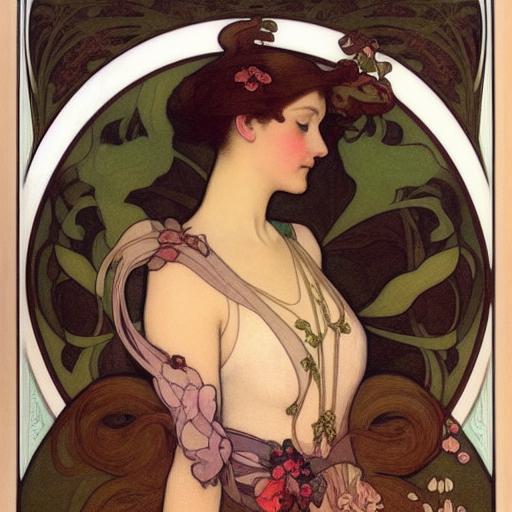Create from prompt to Image
With the AI image generator like DALL-E and Stable Diffusion, we can write a prompt to tell the generator what elements we need. Therefor, it is important for us to understand how the words in the prompt affect the result of the generation. In the prompt “a painting of a woman with ribbon and flower in her hair, an art nouveau painting, Alphonse Mucha, elegant, artistic,” each keyword contributes to shaping the characteristics and style of the painting:
- Woman with Ribbon and Flower in Her Hair: This establishes the central subject of the painting, focusing on a woman adorned with a ribbon and a flower, creating a sense of beauty and femininity.
- Art Nouveau Painting: This indicates the artistic style that will be employed, characterized by flowing lines, intricate details, and organic forms often found in the art of Alphonse Mucha, a renowned Art Nouveau artist.
- Alphonse Mucha: This reference suggests that the painting will draw inspiration from the works of Alphonse Mucha, known for his elegant depictions of women and intricate ornamentation.
- Elegant: This keyword implies that the painting will convey a sense of grace, sophistication, and refinement, reflecting the elegant nature of the subject and the Art Nouveau style.
- Artistic: This keyword emphasizes the artistic expression and creativity that will be infused into the painting, allowing for imaginative interpretations and unique visual elements.
Considering these keywords together, the resulting painting will likely showcase an Art Nouveau-inspired artwork featuring a woman with a ribbon and flower in her hair. The style will incorporate flowing lines, ornate details, and organic motifs, reminiscent of Alphonse Mucha’s iconic works. The composition will exude an elegant and sophisticated ambiance, capturing the timeless beauty of the subject. The artistic approach will add depth and creativity to the piece, inviting viewers to appreciate the artistic expression and intricate details within the painting.
Background of Art Nouveau
Art Nouveau emerged as an influential art movement in the late 19th century, spreading across Europe and eventually reaching other parts of the world. It was a reaction against the prevailing academic art of the time and sought to break free from the constraints of traditional design. Art Nouveau, which translates to “new art” in French, was characterized by its emphasis on organic forms, flowing lines, and intricate details inspired by nature.
The movement embraced a wide range of art forms, including architecture, furniture design, decorative arts, and graphic design. Artists and designers of the Art Nouveau era sought to create a total work of art, where every element of a space or object was harmoniously integrated into a unified whole. The movement’s philosophy was rooted in the idea of art as a way of life, with a focus on beauty, craftsmanship, and a rejection of industrial mass production. Art Nouveau represented a shift towards a more modern and progressive aesthetic, and its influence can still be seen in contemporary design today.
Common elements of Art Nouveau
One of the most prominent features of Art Nouveau is the extensive use of curvilinear forms. Flowing lines and organic shapes inspired by nature, such as plants, flowers, and vines, dominate the artwork. These elegant and harmonious curves create a sense of fluidity and movement, contributing to the overall aesthetic of the style.
Nature and botanical motifs are another common element found in Art Nouveau. Artists often incorporated intricate depictions of flowers, leaves, and plant stems into their designs. These motifs were stylized and embellished, showcasing the beauty of the natural world in a decorative and ornamental manner. The use of these organic forms reflected the desire to break away from the rigid geometric shapes of the previous artistic movements.
Whiplash curves are a distinctive characteristic of Art Nouveau. These exaggerated and sweeping lines add a sense of dynamism and energy to the compositions. They twist and flow, creating a visually captivating effect that captures the viewer’s attention. Alongside these curvilinear forms, Art Nouveau also integrates geometric patterns. These geometric shapes, often intersecting with the flowing lines, provide structure and balance to the overall design.
When using AI image generation to create Art Nouveau-inspired imagery, you can provide the prompt “Art Nouveau” to the AI model. Drawing from its training and understanding of the style’s aesthetics, the AI analyzes the patterns, motifs, and visual characteristics associated with Art Nouveau. It then generates images that incorporate these elements, allowing you to explore and experiment with the iconic Art Nouveau style in a digital medium. The AI’s ability to synthesize the flowing lines, nature-inspired motifs, and stylized figures of Art Nouveau offers a unique opportunity to engage with this artistic movement and unleash your creativity in the digital realm. When finished, you can directly share the image with others, and also input it into other design tool like Visual Paradigm Online to have further adjustment and customization.


